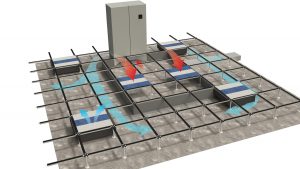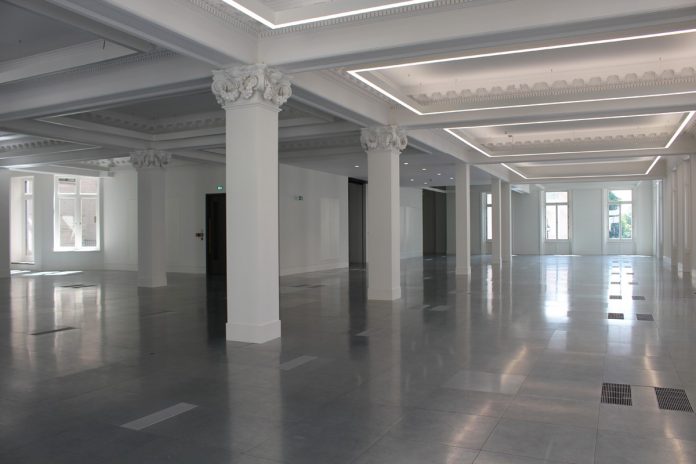Underfloor air conditioning uses the space beneath a raised access floor as the ventilation zone, promoting interior design freedom
Design and architecture trends can lead to a number of challenges for professionals specifying heating, ventilation and air conditioning systems as traditional ceiling-based systems are typically fixed and inflexible due to associated duct and pipework. Making use of the plenum beneath a raised access floor as the ventilation zone for air conditioning can overcome a number of these challenges and, by adopting an air conditioning system that can both supply and return air via the floor plenum, designers are free to make use of ceiling space and features in a very different way, as well as attracting significant savings.
The trendy feature of exposing ceilings in commercial offices lends itself to spacious, open interiors. Structures and beams become interior features and are often left unfinished. Current new build designs incorporate large floor plates, high ceilings and large windows to maximise available light and enhance natural ventilation. In refurbishments, space and access is often restricted. However, there could be scope to add a further floor with dormer windows, often referred to in the industry as a dormer floor.
Underfloor air conditioning has been successfully retrofitted to a number of buildings with said dormer floors. For example, 196 Deansgate in Manchester, 76-88 Wardour Street, London and Network House in Hampton Hill amongst others. Older buildings, even those without add-on floors with dormer windows can also benefit from adopting underfloor air conditioning, consequently eliminating ceiling-based services altogether, maximising the available floor-to-ceiling space and often achieving the British Council for Offices recommended 2.5 meters internal height. The height savings calculated in refurbishments can offer a significant amount of extra available space and subsequently can lead to overall building height savings.
Architects can adopt underfloor air conditioning to achieve their design goals. Jersey Energy undertook a complete refurbishment of the 10,000 sq m Powerhouse building in the early 2000s. The ceiling was a lattice of riveted steel ribs and architects Manser Associates achieved pleasing results with up-lighting and underfloor air conditioning. At the Weighbridge Building in Marlow, designers were able to retain the existing beams by adopting underfloor air conditioning as part of a full refurbishment.
 As well as maximising floor-to-ceiling height, plenum air conditioning also allows architects to retain structural features. Many older buildings have beautiful ceilings, some of which have listed classification and must be preserved; for example, the stunning plasterwork at 8 Waterloo Place, London. Modern buildings may have a lightweight structure in the form of a building envelope, such as the Arup designed Parkview Green building in Beijing. New and older buildings may have an atrium incorporated into the design and, again, underfloor air conditioning systems can satisfy cooling and heating requirements within these expansive areas.
As well as maximising floor-to-ceiling height, plenum air conditioning also allows architects to retain structural features. Many older buildings have beautiful ceilings, some of which have listed classification and must be preserved; for example, the stunning plasterwork at 8 Waterloo Place, London. Modern buildings may have a lightweight structure in the form of a building envelope, such as the Arup designed Parkview Green building in Beijing. New and older buildings may have an atrium incorporated into the design and, again, underfloor air conditioning systems can satisfy cooling and heating requirements within these expansive areas.
The options for providing comfortable heating and cooling in these modern spaces can be limiting and create a number of airflow challenges. Yes, traditional ceiling-based air conditioning systems can be installed; exposing the ductwork can be considered artistic in an industrial way and some will look more aesthetically pleasing than others, but adopting a fully underfloor system allows architects to eliminate pipe and ductwork and experience total design freedom with regards to the ceiling and other high-level features. This option is especially suitable for historical and listed buildings where it simply may not be possible to introduce ceiling-based systems such as chilled beams, VAV systems and fan coils, as they virtually eliminate the possibility of retaining the architectural detail.
Further benefits include excellent indoor air quality and the ability to introduce fresh air into a building without any loss before it is adequately mixed into the space. The partial loss of fresh air directly affects the ability of the selected system to dilute pollutants and minimise cross contamination, whereas underfloor supply systems introduce 100% of the fresh air without loss, creating exceptional quality indoor environments.
Combined with the above is the enhanced user control of such systems. Ceiling-based systems deliver cold air from high level, often causing uncomfortable draughts; they are typically static with fixed, centralised control and users are unlikely to be able to adjust temperature or airflow to suit their optimum conditions. Individual personal control of simple settings can enhance user comfort and satisfaction of the individual’s working environment, and the inherent flexibility of underfloor systems means that fan terminals can easily be relocated to adapt to changing use of the space, as well as reducing fit-out costs.
Considering the above, one must ask whether using a traditional ceiling-based HVAC system as part of an exposed design is the best option for providing comfort cooling to the occupants of the space? Plenum-based systems can offer the best of both, and can easily be adapted and reconfigured for future changes in the use of space and occupant density. Underfloor air conditioning technology can help designers overcome structural and height restrictions, as well as design challenges associated with both new build and refurbishment projects.
Lucy Bonsall
Marketing Manager
AET Flexible Space
Tel: +44 (0)1342 310400
Twitter: @AET_FSS
Please note: this is a commercial profile.














